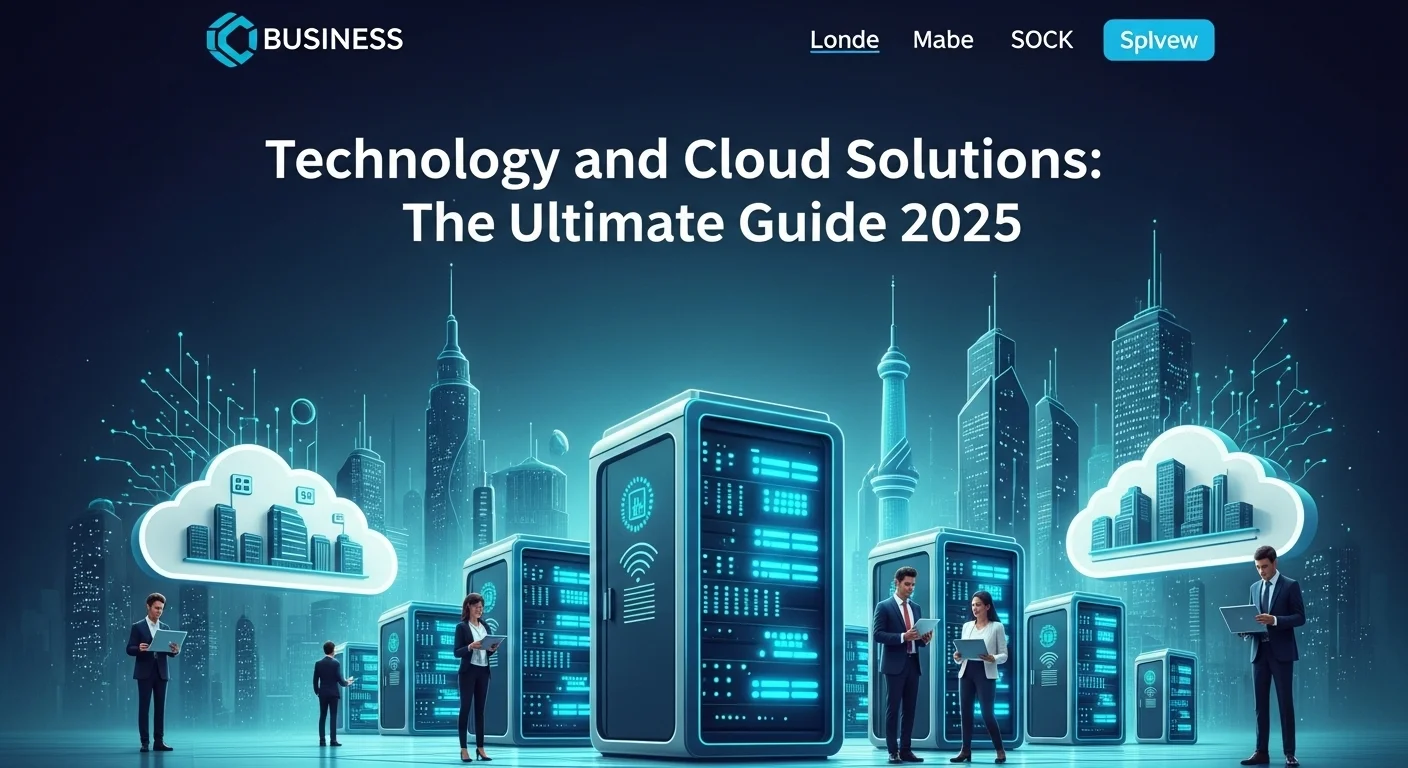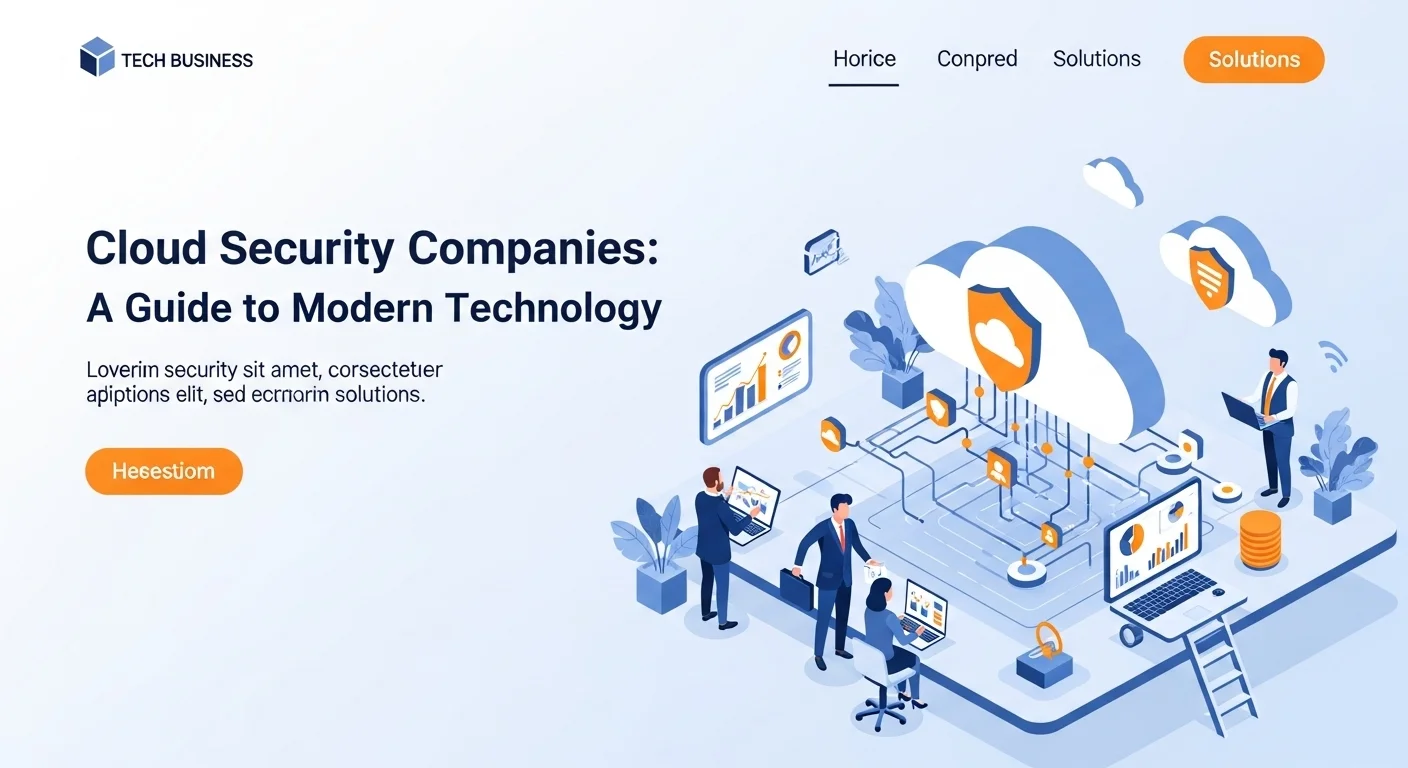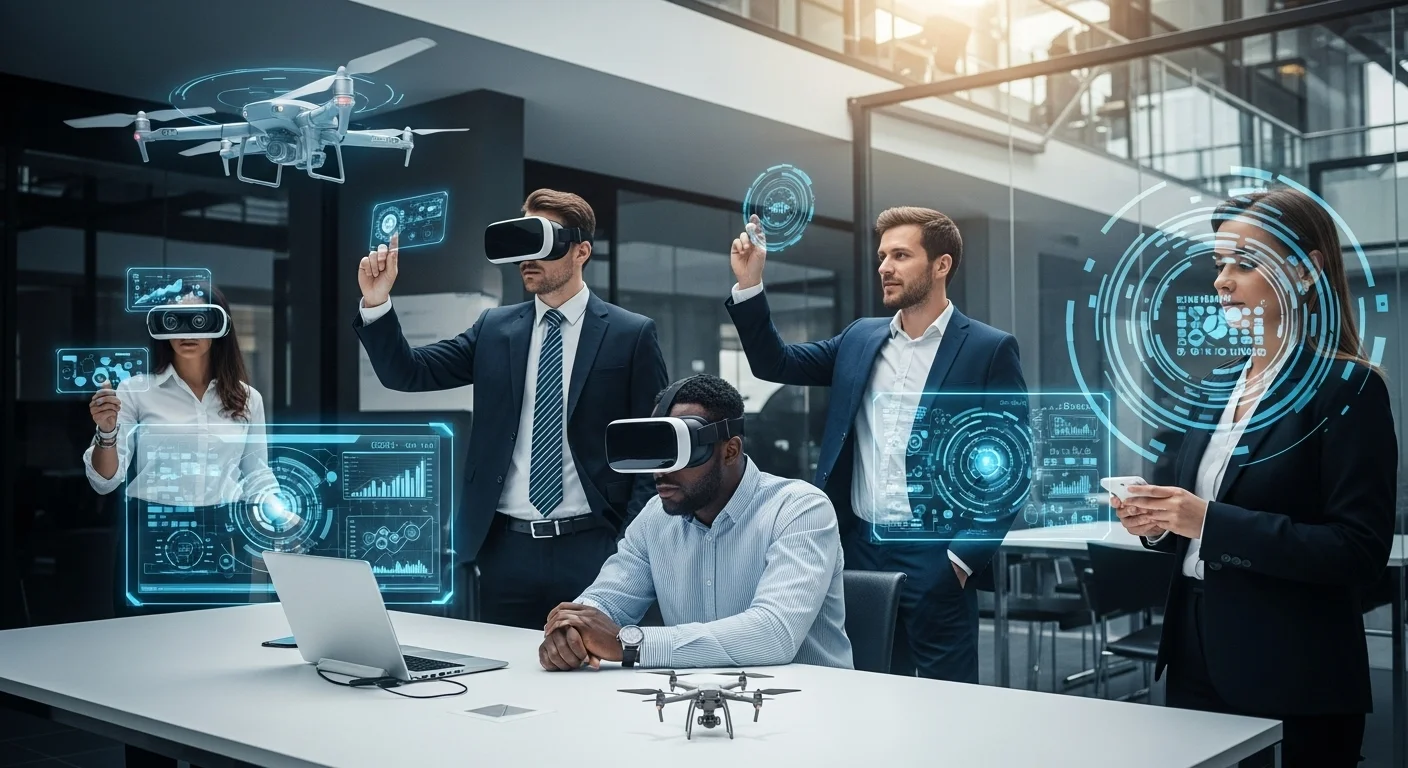Demystifying the Cloud: Your Practical 2025 Guide to Tech and Business Growth

Executive Summary
In my 15 years as a cloud strategist, I've seen 'the cloud' go from a buzzword to the absolute engine of modern business. It's not just for tech giants anymore; it's for everyone. But let's be honest, it can feel complex. This guide is my attempt to cut through the noise. We'll break down what cloud solutions really are, explore the different 'flavors' like IaaS, PaaS, and SaaS in simple terms, and look at how they solve real-world problems in security, data management, and even healthcare. My goal is to give you, whether you're a business leader or just tech-curious, the clear insights you need to make smart decisions. Think of this as your roadmap to using the cloud to boost efficiency, spark innovation, and stay ahead of the curve in 2025.
Table of Contents
Table of Contents
What are Cloud Solutions and why is it important in Technology?
In today's fast-moving digital world, the cloud is everything. But what does that really mean? Simply put, cloud solutions are about using someone else's computers. Instead of buying and managing your own expensive servers in a back room, you rent computing power, storage, and software over the internet from a provider. Think of it like your home's electricity. You don't build a power plant in your backyard; you just plug into the grid and pay for what you use. The cloud does the same for technology, offering incredible flexibility, scalability, and cost savings. It’s become the foundation for nearly every modern application and business, from nimble startups to global corporations, allowing them to innovate faster than ever before.
The Three Main Flavors: IaaS, PaaS, and SaaS
To really get it, you need to know about the three main ways these services are offered. I've always found the 'Pizza as a Service' analogy works wonders here.
- Infrastructure as a Service (IaaS): This is like buying the pizza ingredients—dough, sauce, cheese—and using the pizzeria's oven. You have the most control. In tech terms, you're renting the basic building blocks: servers, storage, and networking. You install your own operating system and applications. It gives you maximum flexibility, and it's the model used by giants like Netflix on platforms like Amazon Web Services (AWS) to build their massive systems.
- Platform as a Service (PaaS): This is like ordering a take-and-bake pizza. The pizzeria provides the platform—the crust, sauce, and cheese are all ready. You just add your own toppings and bake it. For developers, this is a dream. The cloud provider manages the underlying infrastructure and operating system, so your team can focus purely on writing code and building great applications without the operational headaches.
- Software as a Service (SaaS): This is the simplest model—you just order a pizza delivered to your door. You don't worry about anything; you just enjoy the finished product. SaaS delivers ready-to-use software over the internet on a subscription basis. Think Gmail, Salesforce, or Microsoft Office 365. You just log in and use it. It's the most common and convenient form of cloud solution.
Where Your Cloud Lives: Public, Private, and Hybrid
Beyond the service models, you'll also hear about Public, Private, and Hybrid clouds. A public cloud is shared infrastructure, like an apartment building. A private cloud is your own, exclusive infrastructure, like a single-family house, offering more control. A hybrid cloud is the best of both worlds, connecting your private setup with the public cloud to get flexibility where you need it and control where it counts. This strategic choice is why so many businesses now have a 'cloud-first' mindset.
The Real-World Impact on Business and IT
I remember working with a retail company that was crippled by its old, on-site servers. Every holiday season, their website would crash. Moving to the cloud was a game-changer. They shifted from a huge upfront cost for hardware (Capital Expenditure) to a predictable monthly bill (Operational Expenditure). More importantly, they could instantly scale up their server capacity for Black Friday and then scale it right back down. This agility is the cloud's superpower. For IT departments, the focus shifts from just 'keeping the lights on' to driving real business value. Instead of patching servers, they're working on projects that innovate and grow the company.
Specialized Cloud Solutions for Today's Challenges
As the cloud has grown up, we've seen fantastic specialized solutions emerge.
Keeping Your Data Safe: Cloud Security
In the cloud, security is a partnership. The provider secures the cloud's infrastructure, but you're responsible for securing your data within it. That’s why a whole industry of security tools has popped up. These tools help manage who has access to what, prevent sensitive data from leaking, and monitor for suspicious activity 24/7. Getting this right is non-negotiable for protecting your business and your customers' trust.
Powering Your Business: Data in the Cloud
We're all drowning in data, but the cloud gives us a way to make sense of it. Cloud data platforms let you pull all your information from different places into one central hub, like a data lake or warehouse. From there, you can run powerful analytics to spot trends, understand customer behavior, and make smarter, data-driven decisions. This is how raw data becomes your most valuable strategic asset.
Transforming Patient Care: Healthcare in the Cloud
The healthcare industry has unique needs, especially around privacy and compliance with regulations like HIPAA. Specialized healthcare cloud solutions are built to meet these strict standards. They enable the secure sharing of electronic health records, power telehealth appointments that connect doctors and patients anywhere, and provide the immense computing power needed for cutting-edge medical research. It’s not just a tech upgrade; it’s helping build a smarter, more connected healthcare system for everyone.

A Practical Guide to Cloud Technology and Business Solutions
Getting started with the cloud is one thing; mastering it is another. It's a journey that blends smart strategy with the right technical know-how. In my experience, success comes from making informed choices from day one. This guide will walk you through the practical steps, from picking the right cloud partner to designing applications that are built to thrive. We'll look at the technical details without the confusing jargon, focusing on how to use cloud services for IT, data, security, and healthcare to truly transform your organization.
Choosing Your Cloud Platform: AWS vs. Azure vs. Google Cloud
Picking a cloud provider is like choosing a long-term business partner. The three main players—Amazon Web Services (AWS), Microsoft Azure, and Google Cloud Platform (GCP)—are all excellent, but they have different personalities.
- Amazon Web Services (AWS): The original pioneer and market leader. AWS has the widest range of services and the most mature platform. It's a fantastic all-rounder, great for startups that need to scale fast and large enterprises that want a feature for everything. Their documentation and community support are second to none.
- Microsoft Azure: If your company already runs on Microsoft products like Windows Server or Office 365, Azure feels like a natural extension. Its strength lies in this seamless integration and its powerful hybrid cloud capabilities, making it easy to connect your existing data centers to the cloud. It's a top choice for established enterprises undergoing digital transformation.
- Google Cloud Platform (GCP): Google's DNA is in data, AI, and networking, and GCP reflects that. It's a powerhouse for data analytics, machine learning, and modern applications built with containers (using Kubernetes, which Google created). If your business is data-heavy or you're building cutting-edge apps, GCP is an incredible platform.
Honestly, there's no single 'best' choice. It depends on your team's skills, your existing tech, and your specific goals. Many companies I work with even use a multi-cloud approach, cherry-picking the best services from each provider.
Cloud Migration: Strategies for a Seamless Transition
Moving your existing operations to the cloud can feel like a monumental task, but a clear strategy makes all the difference. We often talk about the '6 R's' of migration, but let's simplify it. You can:
- Rehost (Lift and Shift): Move your application to the cloud as-is. It's fast, but you won't get all the cloud benefits. I've seen teams do this just to get out of a costly data center lease quickly.
- Replatform (Lift and Reshape): Move your app and make a few smart tweaks, like swapping your old database for a managed cloud database. This offers a nice balance of speed and improvement.
- Repurchase (Drop and Shop): Ditch your old software and move to a ready-made SaaS solution, like switching from an on-premise CRM to Salesforce.
- Refactor/Re-architect: This is the big one. You redesign your application to be fully cloud-native. It's the most work, but it delivers the biggest rewards in performance and scalability.
- Retire: Simply turn off applications you no longer need. You'd be surprised how many of these are lurking around!
- Retain: Keep some applications on-premise, usually for regulatory or specific performance reasons.
The key is to start small. Migrate a less critical application first to learn the ropes and build confidence before you tackle the big, mission-critical systems.
Technical Deep Dive: Building for the Modern Cloud
Building in the cloud isn't just about moving old habits to a new location. It's about thinking differently. Modern cloud architecture is about being flexible and resilient.
- Microservices: Instead of building one giant, monolithic application, you build it as a collection of small, independent services. I like to think of it as building with LEGOs. If one piece has a problem or needs an upgrade, you can swap it out without knocking down the whole structure.
- Containers and Orchestration: Tools like Docker and Kubernetes are central to modern IT. A container (made with Docker) bundles your application and all its needs into a neat little box that can run anywhere. Kubernetes is the master organizer that manages all these boxes, telling them where to go and what to do. It’s the engine of modern cloud operations.
- Serverless Computing: This is the next level of abstraction. You just write your code, and the cloud provider runs it for you without you ever having to think about a server. It's incredibly cost-efficient for tasks that only run occasionally, as you truly only pay for the split-seconds your code is running.
Implementing Specialized Solutions: A Practical Guide
Let's get practical on how to implement the specialized solutions we talked about earlier.
For robust cloud security: Start with a 'least privilege' mindset. Give users and services only the exact permissions they need and nothing more. Encrypt your data, both when it's moving across the network and when it's sitting in storage. Use firewalls to control traffic and security tools to constantly scan for misconfigurations. Security isn't a one-time setup; it's a continuous process.
For unlocking your data's potential: The journey often starts by creating a 'data lake' to pour all your raw data into. From there, you process and clean it, loading the valuable bits into a high-speed 'data warehouse' for analysis. This is where you connect your business intelligence tools to create dashboards and reports. The real magic happens when you apply AI and machine learning to this data to predict future trends.
For navigating healthcare in the cloud: Compliance is king. Your first step is ensuring your cloud provider will sign a Business Associate Agreement (BAA), a legal necessity under HIPAA. Then, you design your system with strict access controls, detailed audit logs, and powerful encryption to protect patient information at all costs. The goal is to innovate safely, improving patient care while ensuring total privacy.

Tips and Strategies to Master Your Cloud Experience
Operating in the cloud is a marathon, not a sprint. To get the most out of your investment, you need to constantly refine your approach. Here are some advanced strategies I've shared with my clients to help them manage costs, tighten security, and drive real innovation. These tips are designed to make your cloud environment more efficient, secure, and aligned with your business goals, turning it from a utility into a strategic weapon.
Best Practices for Cloud Cost Management: Avoiding Bill Shock
The biggest fear I hear from new cloud adopters is the surprise bill. The ease of spinning up new resources can lead to runaway costs if you're not careful. This is where FinOps (Finance + DevOps) comes in—it's about building a culture of financial responsibility.
- Tag Everything: My number one rule. You can't control what you can't see. Implement a strict tagging policy for every resource. Tag by project, department, or owner. This allows you to see exactly where your money is going and hold teams accountable.
- Right-Size Your Resources: It's human nature to over-provision 'just in case'. Use the monitoring tools your cloud provider offers to find idle or underused virtual machines and databases. Scaling them down to match their actual usage is one of the quickest ways to save money. Also, automate shutdowns for development environments on nights and weekends.
- Use the Right Pricing Model: Don't pay on-demand prices for everything. For steady workloads, use commitment plans like AWS Reserved Instances or Azure Reservations to get discounts of up to 70%. For workloads that can be interrupted, like some data processing jobs, use Spot Instances for massive savings on spare compute capacity.
- Automate Governance: Set up automated budget alerts that notify you when spending is about to hit a limit. You can even write simple scripts to automatically terminate resources that don't comply with your tagging policy. This enforces good habits and prevents costly mistakes.
Advanced Strategies for Cloud Security
In today's threat landscape, basic security isn't enough. You need to be proactive and adopt a more modern, advanced security posture.
- Embrace a Zero Trust Model: The old idea of a secure network perimeter is dead. Zero Trust means what it says: trust no one by default. Every single request to access a resource must be verified, every time, for every user and device. This means enforcing multi-factor authentication (MFA) everywhere and segmenting your network so that even if an attacker gets in, their movement is limited.
- Make Security Part of Your Pipeline (DevSecOps): 'Shift left' by building security checks directly into your development process. Automatically scan your code for vulnerabilities before it's deployed. This finds and fixes problems early, when they're much easier and cheaper to deal with than after a breach.
- Automate Compliance: Manually checking for compliance with regulations like GDPR or HIPAA is a recipe for disaster. Use cloud tools to continuously monitor your environment against hundreds of security best practices and regulatory rules. These tools can alert you to misconfigurations and even fix them automatically.
- Go on the Threat Hunt: Don't just sit back and wait for alarms to go off. Proactively hunt for threats in your environment. Use advanced tools and threat intelligence to look for the subtle signs of a sophisticated attack that might otherwise go unnoticed.
Optimizing Performance and Unlocking Innovation
A well-run cloud environment is both fast and a launchpad for new ideas. Here’s how to achieve both.
For your IT solutions: Use performance monitoring tools to find and eliminate bottlenecks in your applications. Set up auto-scaling to automatically add more power during peak traffic and scale back down to save money. A Content Delivery Network (CDN) is a must for any web application, as it caches your content around the world, making your site load lightning-fast for all your users.
For your data solutions: The goal of data is insight. Connect your cloud data to visualization tools like Tableau or Power BI to create dashboards that empower your teams to make smarter decisions. Then, take the next step. Use cloud AI platforms to build predictive models for things like customer behavior or sales forecasting. This is where your data starts to generate incredible business value.
For healthcare solutions: Look beyond just storing records. Use cloud AI to help radiologists analyze medical images more accurately. Leverage the massive compute power for genomic research to advance personalized medicine. Expand your telehealth services on a secure cloud backbone to connect with patients more effectively. This is how technology can genuinely improve lives.
If you're looking to go deeper, the official provider guides are an invaluable resource. I always recommend the AWS Well-Architected Framework as a starting point for evaluating and improving any cloud architecture.
Ultimately, mastering the cloud is about continuous improvement. By managing costs wisely, adopting an advanced security posture, and always looking for ways to optimize performance, your cloud environment becomes more than just infrastructure—it becomes your greatest strategic asset.
Expert Reviews & Testimonials
Sarah Johnson, Business Owner ⭐⭐⭐⭐
As a small business owner, the cloud always felt overwhelming. This guide was a breath of fresh air. The section on choosing a provider without getting too technical was exactly what I needed. A great start!
Mike Chen, IT Consultant ⭐⭐⭐⭐⭐
I'm an IT consultant, and I've read countless articles on this. This is one of the best. It cuts through the jargon and the author's personal stories on migration projects were genuinely helpful. I'm sharing this with my clients.
Emma Davis, Tech Expert ⭐⭐⭐⭐⭐
Finally! An article that connects all the dots from IaaS to FinOps in a way that makes sense. The breakdown of Zero Trust security was particularly clear. A must-read for anyone in tech.



